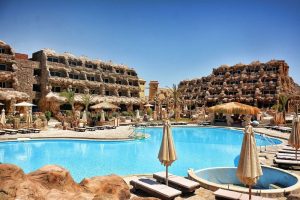The Philippines is one of the best budget travel destinations in the world. With its stunning white-sand beaches, crystal-clear seas, breathtaking sunsets, and friendly locals, it’s a place that feels like paradise. Add to that the tropical vibe and relaxed atmosphere, and it’s easy to see why so many people fall in love with it.
I’ve had the privilege of visiting the Philippines several times, and it never fails to impress. From majestic volcanoes and untouched coral reefs to lush jungles, underground rivers, enormous caves, and some of the most beautiful waterfalls you’ll ever see, there’s no shortage of natural wonders. You can explore WWII shipwrecks while snorkeling, camp in the jungle, or even venture deep into limestone caves.
And the best part? It’s incredibly affordable.
Rum is cheaper than soda, and tasty local dishes like lumpia, pancit, or the famous halo-halo dessert can cost less than a dollar. In many hostels, you can sleep in a hammock for under five bucks a night.
You can easily get by on as little as $20 USD a day if you’re traveling on a tight budget. And if you’re really trying to cut costs, hitchhiking and camping can make things even cheaper. Of course, your budget could increase if you opt for luxury beachfront resorts, dine at upscale restaurants, or take expensive tours.
Here’s a breakdown of typical travel costs in the Philippines for 2023:
- Dorm bed in a hostel: $6–15 USD per night
- Public ferry ride: $6–8 USD
- Jeepney ride: 20–50 cents
- Street food: $1.50–4 USD
- Restaurant meals: $5–7 USD
- Long-distance bus: $8–10 USD
- Domestic flight: $50–90 USD
- Local beer: $2–3 USD
- 1.5L bottle of water: 75 cents
- Island-hopping: $15–25 USD
- Diving with whale sharks: $25-50 USD
Accommodation: While posh hostels can cost up to $20 USD a night, there are plenty of budget options outside of Manila. For instance, in Palawan, dorm beds start as low as $6 USD. Many hostels offer basic amenities like Wi-Fi and air conditioning. If you prefer something even cheaper, local guesthouses or beachside huts can go for as little as $2 USD a night.
Food & Drink: Street food is super cheap, with tasty dishes like mystery meat skewers starting at just $1 USD. In touristy areas, restaurants can charge more, with meals ranging from $6 to $20 USD. If you’re in places like Manila, food and drinks can add up, especially on a night out. But don’t worry, a coconut for hangover relief will cost you less than a dollar.
Transportation: Flights within the Philippines can get pricey, so ferries are a great option if you’re on a budget. Long-distance buses are also available on bigger islands like Luzon, but ferries are often the only way to reach many of the islands.
Activities: The Philippines is one of the cheapest places to learn how to dive, with rates starting around $30 USD, though $50 USD is more common. Snorkeling is even cheaper, with gear rental available for $3–5 USD on many beaches.
How much you spend in the Philippines really depends on your travel style. Areas like Manila and Boracay are pricier, but if you stick to the less touristy regions, you can easily get by on $35-40 USD a day.
With a budget of $35 USD a day, you can stay in a decent shared room or a comfortable dorm in a cool hostel. You’ll also have plenty left over for three meals a day, some Uber rides, and a few beers in the evening.
If you want to save even more, here are a few tips:
- Stay with locals: Couchsurfing is popular here, and it’s a great way to meet people and save on accommodation. If that’s not your thing, locally-run guesthouses are often cheaper than hostels.
- Look for Air Asia deals: Air Asia is one of the most affordable airlines in the region, with frequent sales on internal flights. It’s worth signing up for their newsletter to get the best deals.
- Buddy up: Many activities are cheaper when you split the cost with a group.
- Hitchhike: Hitchhiking is common in the Philippines and can be a fun, budget-friendly way to travel. While it’s generally safe, always trust your instincts and avoid rides with drivers who seem impaired.
- Eat where locals eat: Skip the touristy spots and go where the locals eat. You’ll find better food at lower prices.
- Camp: If you’re really trying to save, bring a tent and camp on one of the beautiful beaches. Many hostels also let you pitch a tent for free if you’re buying drinks at the bar.
- Bring a water bottle: Tap water isn’t safe to drink in the Philippines, so invest in a reusable water bottle with a built-in filter, like a Lifestraw, to save money and stay safe.
The Philippines is, without a doubt, my favorite country in Southeast Asia. Don’t wait too long to visit before the secret gets out and the crowds arrive!







